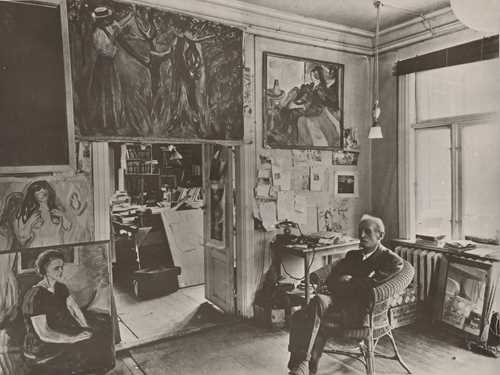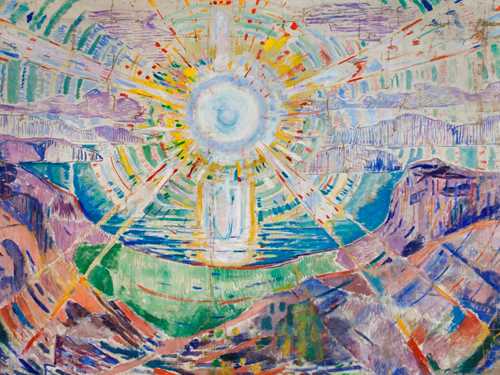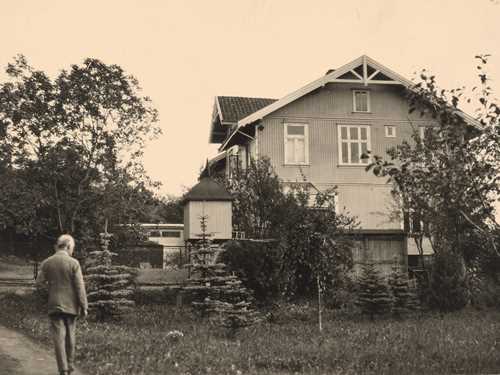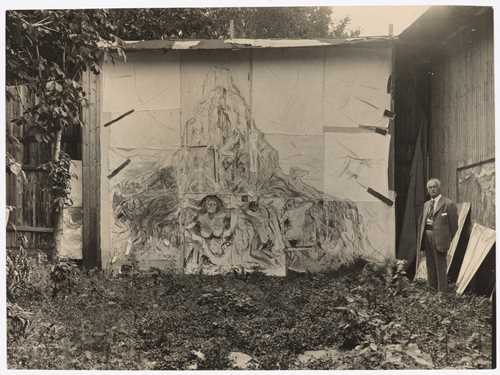Munch’s largest paintings have to be lifted through the museum wall
Paintings which are up to 50 square meters in size are transported on barges and lifted by crane through a slot on the sixth floor of the new museum.
Made by MUNCH in collaboration with NRK
Some of the paintings in MUNCH’s collection are so enormous that you cannot get them in or out of the museum in the normal way. For these works, which are up to 50 square meters in size, one has simply had to open a slot in the wall on the sixth floor of the new museum. The works are transported in specially made crates with a trailer and out on a barge, before being lifted by crane into the opening on the museum’s sea side, more than 26 meters above ground level. Then the 60 cm wide and 7.1 metres-high slot is being closed again – for good.
There are two paintings that are so large that they must be moved in this way – The Sun and The Researchers. Both of these works are very valuable and also fragile, and in combination with the unmanageable size, the move to the new museum in Bjørvika is very demanding.
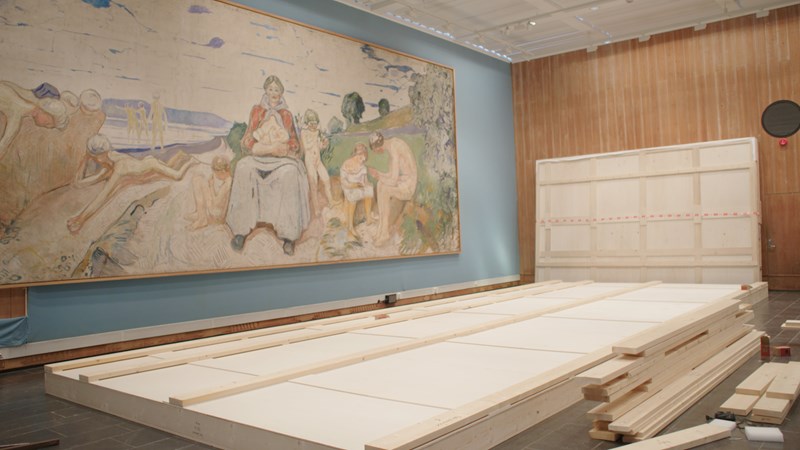
The researchers is the largest painting in the collection - almost 50 square metres. Here pictured in the lecture hall in Tøyen before being packed down. Photo: Munchmuseet
Edvard Munch had the paintings hanging in his outdoor studio and the pictures are marked by the occasionally rough treatment. In addition, the canvas is thin and the paint layers heavy. Vibrations during the move can cause portions of paint to loosen, and the museum’s curators have therefore spent several months restoring and securing loose flakes and parts to the paintings.
Tough ride
From Tøyen, the sealed boxes are hoisted up through the roof before being placed aboard an extra long truck upon which a wooden skeleton, a so-called a-frame, has been built. The precious cargo is then being driven with police escorts the 2.8 km long stretch to Bjørvika. The painting crates must be inclined in the loading plane because lampposts and power lines for trams restrict the height of the load.
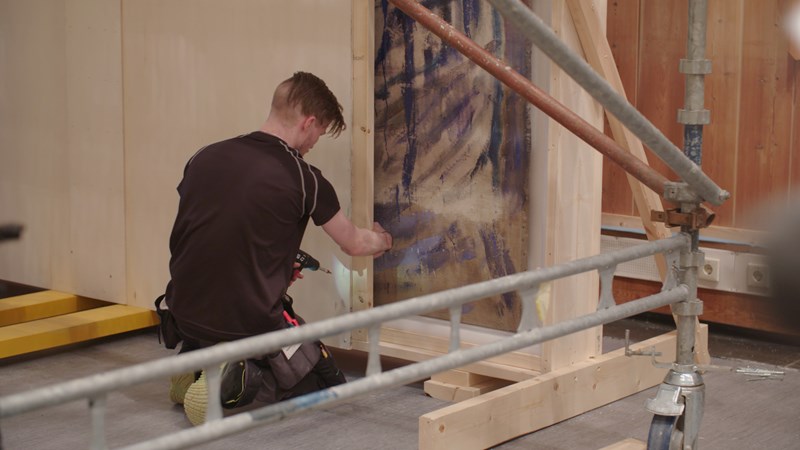
The precious cargo is carefully secured before departure. Photo: Munchmuseet
In Bjørvika, the boxes are moved to a barge that takes the sea route from Sørenga and over to the new MUNCH. The reason for not loading over the barge closer to the museum, for example at Sukkerbiten, is that the angle of the crossing would then be more demanding. That area also provides less space and accessibility. After their arduous journey, the paintings can be safely mounted inside the new MUNCH. Here they will hang in a specially built hall that extends over two floors, making it possible to view them from several levels.
This is “Monumental”
The works that go under the collective classification “Monumental” form the basis for the permanent exhibition of the same name in new MUNCH. The two largest paintings The Sun and The Researchers were created in connection with a commissioned assignment to decorate the University Hall.
The paintings for the University’s auditorium were among the most demanding projects in Munch’s career. From the competition was announced in 1909 until 1916, when the final versions were presented to the public, he worked intensely. He executed and took care of several hundred drafts and sketches, and these are also part of MUNCH’s collection today. Some can also be seen in the exhibition Edvard Munch Monumental.
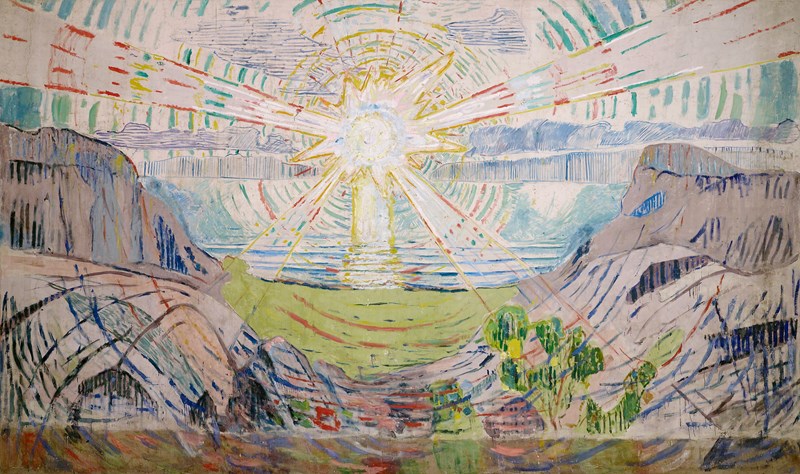
Edvard Munch: The Sun, 1910–11. Oil on canvas. Photo © Munchmuseet.
The Sun is the first of the monumental works – and in fact the first artwork at all – to be moved to Bjørvika. It is also considered one of Munch’s masterpieces. This version is a draft of the Auditorium Frieze that the artist made in full size in 1910-11. The work measures about 4.5 by 8 metres – around 35 square meters.
“I painted the sun”
In the University Hall The Sun is placed centrally in the middle of the eleven motifs. The sun’s rays stretch towards the side panels, which display nude men and women stretching out towards the light. The motif circle reflects, among other things, Munch’s interest in nature and vitalism, a scientific and philosophical movement that fronted health, hygiene and physical education, and which emphasized the sun as an energizing force.

In the old museum building in Tøyen, the specially made crates are liftet through a hole in the roof. Photo: Munchmuseet
The theme for the concept he won the decorating job with is “enlightenment”. The artist expressed this in a radical pictorial language, inspired by the cultural currents of the time. As the motif appears today, The Sun unites past and present, body and spirituality. Munch himself described its origins in two short sentences: “I saw the sun rise up above the rocks – I painted the sun.”
Smuggled out several times
With its 4.8 times 11 metres The Researchers is the largest of the works. The title refers to the children who dig in the sand and explore the world around the breastfeeding woman in the middle, who can evoke associations with the Virgin Mary in Christian visual culture. However, she is often interpreted as a symbol of the university’s mother, who provides nourishment and power to new generations, or even of the universe: The painting was referred to as “Mother Earth” both in newspaper articles and in interviews with Munch.
Munch also created another version of this motif – the painting Alma Mater which hangs in the University’s auditorium. But as he was unable to decide which version he liked best, he hung The Researchers over Alma Mater in the Aula several times, most recently in 1939 – five years before he died.
The Aula, The University of Oslo. Alma Mater is on the right hand and the Sun in the centre. Photo: Jaro Hollan © Munchmuseet
Thus, this is not the first time that The Researchers have been “smuggled” out the back door. When Germany occupied Norway during World War II, it was this version that hung in the university auditorium, and together with the other works in the frieze, the painting was cut down in a hurry and brought to safety in Kongsberg’s mines.
After the war, the university’s management decided that it was Alma Mater that would hang in the auditorium, and The Researchers became part of the collection Oslo Municipality took over from Edvard Munch’s estate.
